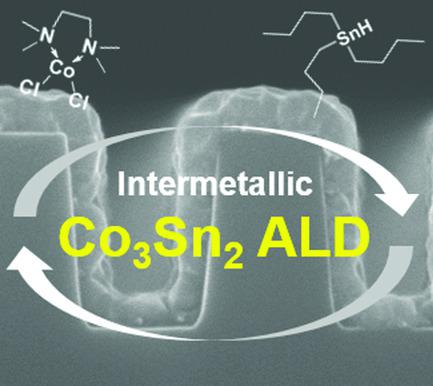当前位置:
X-MOL 学术
›
Adv. Mater. Interfaces
›
论文详情
Our official English website, www.x-mol.net, welcomes your feedback! (Note: you will need to create a separate account there.)
Atomic Layer Deposition of Intermetallic Co3Sn2 and Ni3Sn2 Thin Films
Advanced Materials Interfaces ( IF 5.4 ) Pub Date : 2018-10-16 , DOI: 10.1002/admi.201801291 Katja Väyrynen 1 , Timo Hatanpää 1 , Miika Mattinen 1 , Kenichiro Mizohata 2 , Kristoffer Meinander 2 , Jyrki Räisänen 2 , Joosep Link 3 , Raivo Stern 3 , Mikko Ritala 1 , Markku Leskelä 1
Advanced Materials Interfaces ( IF 5.4 ) Pub Date : 2018-10-16 , DOI: 10.1002/admi.201801291 Katja Väyrynen 1 , Timo Hatanpää 1 , Miika Mattinen 1 , Kenichiro Mizohata 2 , Kristoffer Meinander 2 , Jyrki Räisänen 2 , Joosep Link 3 , Raivo Stern 3 , Mikko Ritala 1 , Markku Leskelä 1
Affiliation

|
Intermetallics form a versatile group of materials that possess unique properties ranging from superconductivity to giant magnetoresistance. The intermetallic Co–Sn and Ni–Sn compounds are promising materials for magnetic applications as well as for anodes in lithium‐ and sodium‐ion batteries. Herein, a method is presented for the preparation of Co3Sn2 and Ni3Sn2 thin films using diamine adducts of cobalt(II) and nickel(II) chlorides, CoCl2(TMEDA) and NiCl2(TMPDA) (TMEDA = N,N,N′,N′‐tetramethylethylenediamine, TMPDA = N,N,N′,N′‐tetramethyl‐1,3‐propanediamine) combined with tributyltin hydride. The films are grown by atomic layer deposition (ALD), a technique that enables conformal film deposition with sub‐nanometer thickness control. The Co3Sn2 process fulfills the typical ALD qualifications, such as self‐limiting growth, excellent film uniformity, and conformal coverage of a trench structure. X‐ray diffraction (XRD) shows reflections characteristic to the hexagonal Co3Sn2 phase, which confirms that the films are, indeed, intermetallic instead of being mere alloys of Co and Sn. The films are extremely pure with impurity levels each below 1.0 at.%. Ni3Sn2 films similarly exhibit the expected XRD reflections for the intermetallic phase and are of high purity. The Co3Sn2 film show magnetic hysteresis with high coercivity values exceeding 500 Oe, indicating great potential in terms of applicability of the films.
中文翻译:

金属间Co3Sn2和Ni3Sn2薄膜的原子层沉积
金属间化合物形成了一组通用的材料,这些材料具有从超导性到巨大的磁阻的独特特性。金属间化合物Co-Sn和Ni-Sn是有前途的材料,可用于磁性应用以及锂离子电池和钠离子电池的阳极。本文介绍了一种使用钴(II)和氯化镍(II)的二胺加合物,CoCl 2(TMEDA)和NiCl 2(TMPDA)制备Co 3 Sn 2和Ni 3 Sn 2薄膜的方法(TMEDA = N,N,N ',N'-四甲基乙二胺,TMPDA = N,N,N ',N'-四甲基-1,3-丙二胺)与氢化三丁基锡结合。薄膜是通过原子层沉积(ALD)进行生长的,该技术可以通过亚纳米厚度控制实现保形膜沉积。Co 3 Sn 2工艺满足典型的ALD资格,例如自限生长,优异的膜均匀性和沟槽结构的保形覆盖率。X射线衍射(XRD)显示了六方形Co 3 Sn 2相的反射特征,这证实了薄膜实际上是金属间化合物,而不仅仅是Co和Sn的合金。该膜是极纯的,杂质含量均低于1.0 at。%。镍3锡2薄膜同样显示出金属间相的预期XRD反射,并且纯度很高。Co 3 Sn 2膜显示出具有超过500Oe的高矫顽力值的磁滞,这在膜的适用性方面显示出巨大的潜力。
更新日期:2018-10-16
中文翻译:

金属间Co3Sn2和Ni3Sn2薄膜的原子层沉积
金属间化合物形成了一组通用的材料,这些材料具有从超导性到巨大的磁阻的独特特性。金属间化合物Co-Sn和Ni-Sn是有前途的材料,可用于磁性应用以及锂离子电池和钠离子电池的阳极。本文介绍了一种使用钴(II)和氯化镍(II)的二胺加合物,CoCl 2(TMEDA)和NiCl 2(TMPDA)制备Co 3 Sn 2和Ni 3 Sn 2薄膜的方法(TMEDA = N,N,N ',N'-四甲基乙二胺,TMPDA = N,N,N ',N'-四甲基-1,3-丙二胺)与氢化三丁基锡结合。薄膜是通过原子层沉积(ALD)进行生长的,该技术可以通过亚纳米厚度控制实现保形膜沉积。Co 3 Sn 2工艺满足典型的ALD资格,例如自限生长,优异的膜均匀性和沟槽结构的保形覆盖率。X射线衍射(XRD)显示了六方形Co 3 Sn 2相的反射特征,这证实了薄膜实际上是金属间化合物,而不仅仅是Co和Sn的合金。该膜是极纯的,杂质含量均低于1.0 at。%。镍3锡2薄膜同样显示出金属间相的预期XRD反射,并且纯度很高。Co 3 Sn 2膜显示出具有超过500Oe的高矫顽力值的磁滞,这在膜的适用性方面显示出巨大的潜力。


























 京公网安备 11010802027423号
京公网安备 11010802027423号